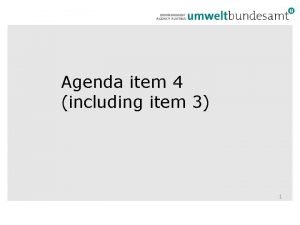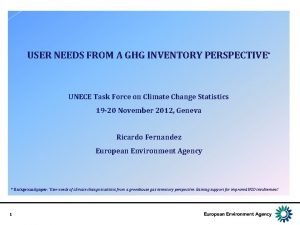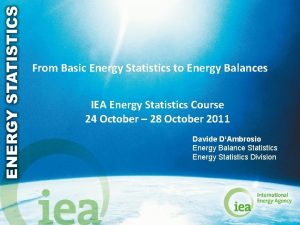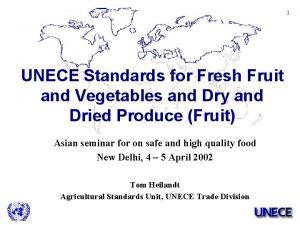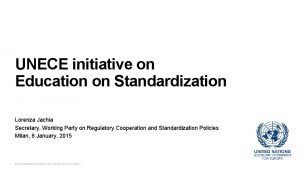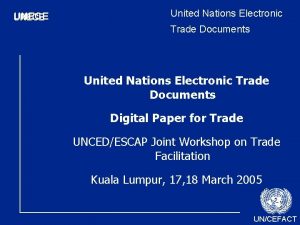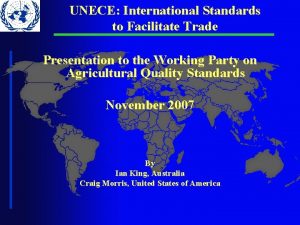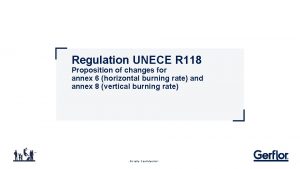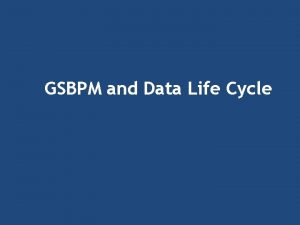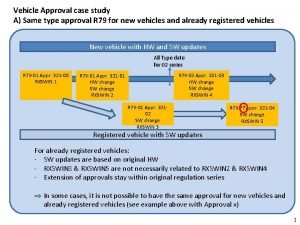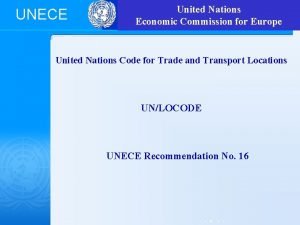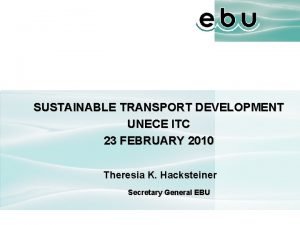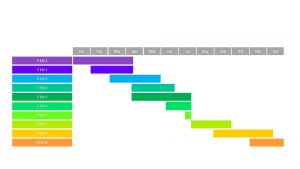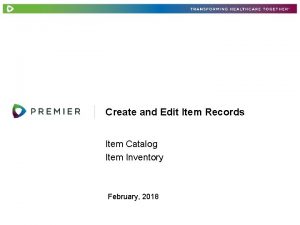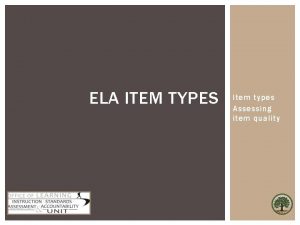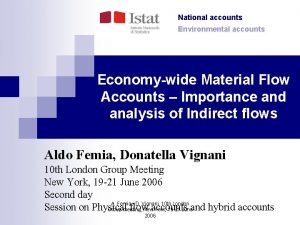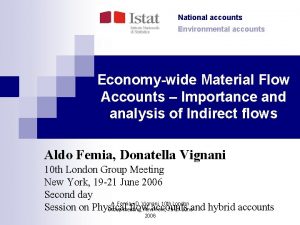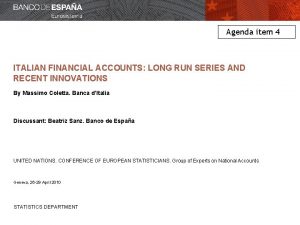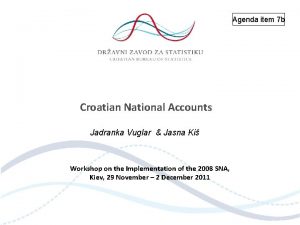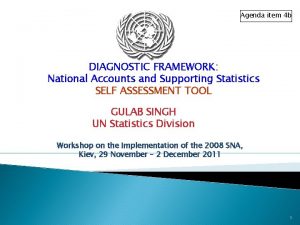Agenda item 4 UNECE National Accounts Financial Accounts






















- Slides: 22

Agenda item 4 UNECE – National Accounts Financial Accounts Michael Connolly – National Accounts, CSO Ireland April 2010

Theory and Practice of Holding Gains and Losses – Is the importance of revaluation reflected in the National Accounts ? Vaclav Rybacek, Czech Statistical Office WGGNA - Merchanting April 2010

Structure of Paper Theoretical arguements - wealth v’s saving Changes in Net wealth resulting from changes in relative prices Savings are Disposable income less final consumption Practical issues – compilation of revaluation account Discussion and Conclusions UNECE – Financial Accounts April 2010

Theory and Practice - Holding Gains and Losses Discussion on the link between Savings and Revaluation Purpose of National Accounts to provide database on consumption and savings behaviour of agents Highlights the fact that Use of Disposable income account excludes revaluations 4 UNECE – Financial Accounts April 2010

STOCK –FLOW FOR QUOTED EQUITY Opening Position 1 Jan 2010 Net Purchases (+)/Sales (-) Foreign exchanges Market Price Changes Other Closing Changes Position 31 March 2010 10 +5 +5 0 120 Holding gains/losses Revaluation = +10 5 National Accounts Income 10/25/2020

Theoretical Arguements - Wealth v’s Saving The impact of Holding Gains/Losses on consumption behaviour Wealth effect - gains on Financial assets or real estate gains (capital account) have an impact on consumption Keynes windfall gains and losses - exclude from disposable income High volatility of gains/losses – not sufficiently strong permanent component => exclude holding gains from Disposable Income Revaluation not considered as a source of consumption or saving in SNA/ESA UNECE – Financial Accounts April 2010

Theory and Practice - Holding Gains and Losses Example given of the use of the proceeds of sale of CEZ shares to fund pension reforms – is this revaluation or disinvestment and reinvestment? Distinction between “expected” and “pure” holding gains Some link between production and expected holding gains - is this related to the projection of future earnings? Impact of tax on gains – included in non-financial accounts while impact of gains are excluded 7 UNECE – Financial Accounts April 2010

STOCK –FLOW FOR QUOTED EQUITY 1. OS +T+OC+R = CS Opening Position Net Purchases/Sales Foreign exchanges Market Price Other Changes Closing Position 120 -10 0 0 110 0 Holding gains/losses Revaluation = 0 2. OS + (S - GCF) +OC+R = CS (substituted T with saving – capform) 8 UNECE – Financial Accounts 10/25/2020

Theoretical Arguements - Wealth v’s Saving Don’t really know if transactions are always equivalent to saving less capital formation How does disinvestment fit into this analysis? For any asset, the balance sheet change, the difference between S (Saving) and I (Cap. Form) are taken up by financial investment (also I) Therefore for any given asset-liability the balance sheet change is equal to I (investment) and revaluations plus other changes UNECE – Financial Accounts April 2010

Theoretical Arguements - Wealth v’s Saving Therefore for any sector the net sum of net worth changes Δ Net Worth = Saving +Reval and Other changes The net revaluation can provide a potential source of funds – wealth effect Actual withdrawal from accumulated assets is disinvestment WGGNA - Merchanting April 2010

Compilation of Revaluation Accounts Quantification of revaluation is a difficult task asymmetric information from two sides of a financial transaction Use of single source - assets side to produce accounts Data sources – 11 Surveys transactions, revaluation and other changes reported Banking statistics and admin data - transactions and revaluation derived from stock data Derivatives and securities other than shares most problematic UNECE – Financial Accounts April 2010

Compilation of Revaluation Account Discussion regarding Table 1 - how is it that the financial assets and liabilities do not balance for the overall economy ? Does it exclude ROW ? “Rise in net worth caused by Non-financial assets. ” Is this a structural point related to the Czech Republic only? Some further elaboration if possible in relation to AF. 7 Other Payables data issues. WGGNA - Merchanting April 2010

Observations IFRS 9 - introduces the revaluation effect into the Profit and Loss accounts for corporations It is clear that revaluation or holding gains/losses have an impact on consumption and disposable income The savings measure is more correctly required to reflect the total of disposable income over final consumption Importance of revaluations in business cycle analysis through real and neutral holding gains/losses 13 UNECE – Financial Accounts April 2010

Conclusions Careful how we think about reval We can have a wealth effect arising from revaluations Once we liquidate these assets with positive revaluation we have a disinvestment - offset by another investment The proceeds are used to invest elsewhere or in bank deposits or Capital Formation. The dominant strategy in an ever rising price level environment is to be a holder of non-financial assets (property) and a debtor ? ? ? WGGNA - Merchanting April 2010

Financial Accounts in Hungary Csaba Ilyes, Head of Financial Accounts Division, Magyar Nemzeti Bank (Central Bank of Hungary) 15 UNECE – Financial Accounts April 2010

Purpose and Characteristics Development of the Financial (transactions) and Balance Sheet (positions) Accounts in Hungary since 2003 Quarterly and Annual time series from 1990 Principles 16 valuation, substance over form etc. Accruals accounting Market prices ∑ components of changes of stocks ≡ changes in stocks Correspondence between assets and liabilities Consistency - consolidated/non consolidated – annual/quarterly UNECE – Financial Accounts April 2010

Purpose and Characteristics Market valuation and difficulties with non-traded securities Methodologies – Accruals, Position plus accrued interest, Institutional sectors Presentation, stock –flow, consolidation, Quarterly vs annual accounts, revisions etc. Institutional Units - Institutional Sectors Data sources UNECE – Financial Accounts April 2010

Data sources: 18 Central Bank(BOP, Monetary Statistics, Securities stats) Annual reports of Corporations Supervisory reports (Pension Funds, Investment Funds etc. ) Tax Returns for corporate balance sheets Government budgetary data NPIs from CSO UNECE – Financial Accounts April 2010

Data Data hierarchy (1. Securities, 2. BOP 3. MFI Balance Sheets. . . . 8. NPIs) Data gaps - cash, loans, insurance technical reserves, derivatives and other receivables are incomplete? NFCs, h/h good quality Estimations - flows from stocks, valuations from currency changes Net lending /borrowing - less reliable that for Non. Financial Accounts Impact of inflation on income and positions Co-operation with CSO/Central Bank to reduce imbalances B 9/B 9 f UNECE – Financial Accounts April 2010

Conclusions and Questions Use of a single source at instrument level - good for symmetry assets/liabilities - could obscure data problems Quality of household data - “Financial Accounts of Households are of high quality” related to financial intermediaries Substantial use of Administrative records – align with ESA /SNA accounting standards 20 UNECE – Financial Accounts April 2010

Conclusions and Questions Is it really appropriate to measure difference between B. 9 and B. 9 f as a % of GDP? Are the B. 9 and B. 9 f for Govt and Corporations generally positive and ROW and H/Holds generally negative? What about SPEs in Hungary? Financial Accounts can be compiled by Central Bank or NSI - which is optimal? Does it depend on who is the BOP compiler? UNECE – Financial Accounts April 2010

Thank you for your attention WGGNA - Merchanting April 2010
 Item-item yang berkaitan ditampilkan bersama
Item-item yang berkaitan ditampilkan bersama Unece
Unece Unece
Unece Cenelec vs atex
Cenelec vs atex Unece
Unece Tailor information
Tailor information Unece
Unece What is the unfccc
What is the unfccc Unece nuclear energy
Unece nuclear energy Unece standards
Unece standards Unece
Unece Electronic trade documents
Electronic trade documents Unece
Unece Unece cyber security
Unece cyber security Unece 118
Unece 118 Geoffrey hamilton unece
Geoffrey hamilton unece Gsbpm
Gsbpm Rxswin example
Rxswin example Un/locode list download
Un/locode list download Unece transport
Unece transport Unece r16
Unece r16 Agenda sistemica y agenda institucional
Agenda sistemica y agenda institucional Generally accepted accounting principles constrain
Generally accepted accounting principles constrain






